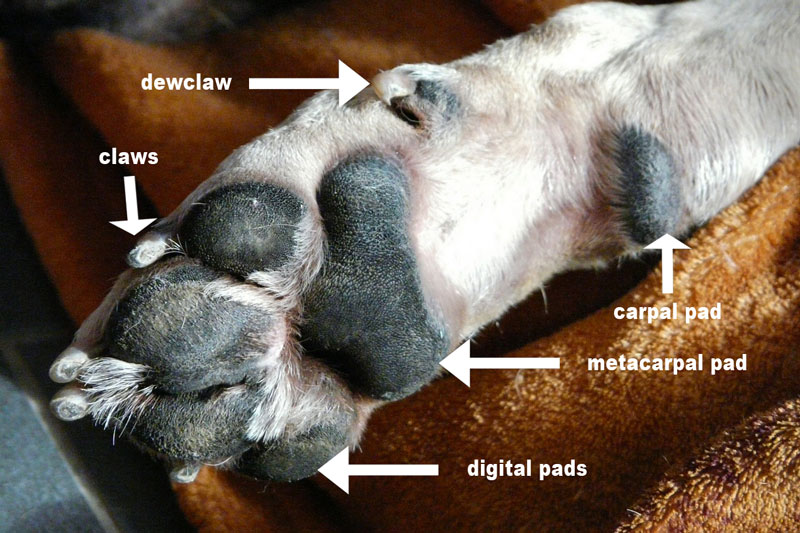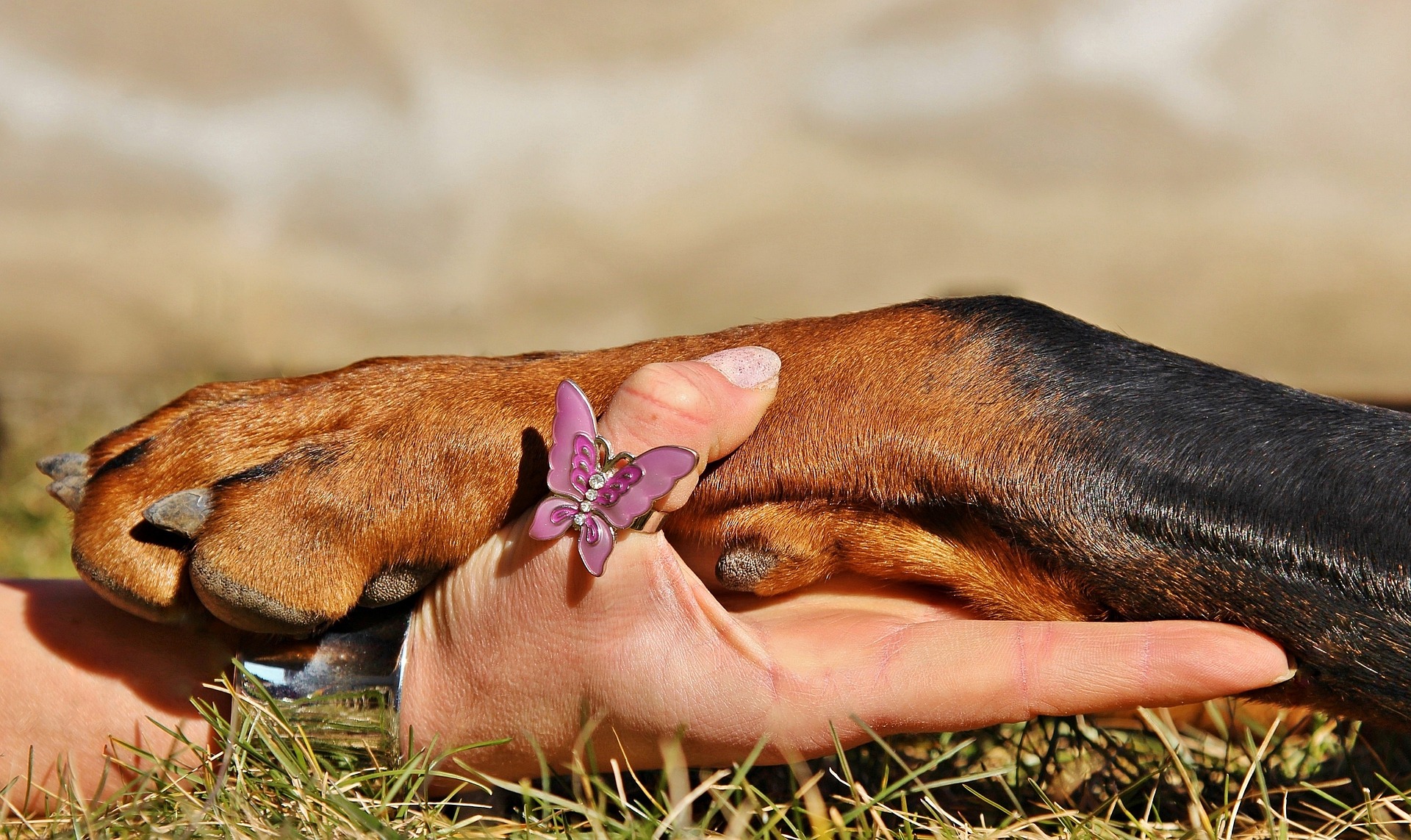Unlike humans, dogs walk around in their four. The dog paws comprise of a thick layer of pads that help to hold its weight and protect from minor scratches.
Composition of Dog’s paw
Along with bones and cartilages, the dog’s paw includes skin, tendons, ligaments, blood vessels and connective tissue. The digital and metacarpal pads work as shock absorbers and help protect the bones and joints in the foot. The outer layer or carpal pads work like brakes, of sorts, and help the dog navigate slippery or steep slopes.
The feel of their pads differs according to their surrounding. Dogs that are outside a lot and exposed to rough surfaces have thicker and rougher paw skin while those who stay indoors have softer pads.

A dog’s paw isn’t free from problems. Get in touch with doggy daycare in Des Moines to ascertain common dog paw problems.
8 common Dog Paw Problem
A dog’s paw can attract different kinds of problems. The weather and climate, daily diet, lifestyle, and hygiene may determine the condition of dog paws.
a. Allergies
Dogs are prone to allergies. The allergic condition can make their paws very itchy. They will typically bite, lick, or chew on them to attempt to relieve the itching. In some cases, excessive licking of the paw can cause irritation or injury and can make it more susceptible to secondary fungal and bacterial infections.
b. Fungal and Bacterial Infections
The fungal or bacterial infection is common in canines. Many different species of bacteria and fungi normally live on your dog’s paw however they only become an issue when these organisms can grow out of control and cause infection. Signs of an infection include redness, swelling, pain, itching, and drainage. Yeast and ringworm are the most common fungus that may infect your pets’ paws.
c. Nail issues
Long toenails are common and can have a lot of negative consequences for your dog. Long nails can make it more difficult for your dog to walk.
Ingrown nails that those which are not trimmed properly or naturally worn down by walking outside can become painful ingrown toenails.
Torn or fractured nails occur when your dog catches their toenail on something. Fractured nails are generally caused by accidents.
d. Dry and Cracked Paw Pads
Warm weather, exposure to the rough surface, winter, chemicals, dry air, and excessive licking can cause dry and cracked paw pads. Dry and cracked paws can be painful and put your dog at a risk for infection.
e. Burns and Blisters
Dogs can suffer burns or blisters in the hot weather! The hot pavement or asphalt road can cause your dog to suffer a burn. If it is too hot for you to walk outside barefoot, it is too hot for your dogs, too! Always feel the pavement with the bottom of your bare hand before letting your dog walk on it. If you cannot comfortably hold your palm to the asphalt for 10 seconds or more, it is too hot for your dog’s paws.
f. Cuts and Abrasions
Cuts, abrasions, or lacerations are caused by walking on sharper objects such as broken glass, small rocks, and sticks, burrs, etc. You must be careful when you allow your dog to play outdoors. Keep them off of any surface you aren’t familiar with.
g. Parasites
Dogs who roam around outdoors can easily get tick infection. Ticks hideout between a pet’s toes where they can cause all sorts of problems, including pain and infection. You must consult a vet to remove the tick. If you remove it yourself, be prepared to use tweezers or special tick removal tools to grip the tick from the head and gently pull it out.
h. Cysts and Growths
Cysts are the sac of tissues that are filled with another substance, such as air or fluid. Cysts, lumps, and growths can commonly occur on paws or in-between your dog’s toes. Contact your veterinarian if you spot one and they can treat and remove if necessary.

How to protect your Dog’s paws?
Always consult with doggy daycare in Des Moines to diagnose dog paw problems. Here is what you can do to prevent serious paw infections and injuries.
i. Keep your dog's nails trimmed
Long nails for the dog are always problematic. They can unnecessarily spread their toes when they walk and the empty spaces between their toes will accumulate dust or snow. Untrimmed nails can also affect your dog's weight distribution, pushing their overall weight onto the back of their feet. Keep your dog’s nails trimmed and short all the time. If your dog often wanders outside, you must take extra precautions with their nails.
ii. Trim the fur between Toe pads
By trimming the fur between their toe pads you’ll level the pad fur with the pads themselves. This prevents snow, salt, and grit from accumulating between the toes. Compacted snow salt on your dog's feet makes walking difficult for them and can also affect their ability to stay on their feet.
iii. Lubricate paws before heading outdoors
Cold weather, ice, and salt can cause your dog's pads to dry out and crack. You can prevent this by wiping his paws with Vaseline or cooking spray before you take him out for a walk. Be sure to keep him off slick surfaces inside the house, such as tile, and outside the house, such as ice.
iv. Consider dog booties
Dog booties are a great way to keep your dog's feet safe and in good condition, particularly when the ground is hot, wet, or snowy. Dog booties are like human shoes that provide optimum protection dust, heat, snow, and other forms of dust. Wearing booties can be difficult for dogs. Try a gradual approach and let them sink into it for a while. Let them wear booties inside the house for short periods of time and offer them a prize or treats
v. Check your De-icer
De-icer is used during winter to de-ice the icy particles on cars. It can produce salt and other ice-melting granules or chemicals that can irritate your dog's paws when contacted. It can also cause stomach ailments if ingested. When choosing a De-icer you should consider buying non-toxic options, such as sand, gravel, and non-clumping cat litters. If you do use salt or chemical deicers, choose to buy "pet safe" brands. Keep the chemicals inside the shelf all the time.
vi. Wash your dog's paws after walks
After roaming outside, consider washing their feet with warm water. This helps to warm up their cold paws. It will also wash off any salt or deicing chemicals residue formed between their toes.
vii. Apply Vaseline on Dog’s Paws
The snow, ice, and salt can cause your dog's pads to dry out and crack. You should consider wiping their paws with Vaseline or cooking spray before you take them outdoors. Consider keeping them off slick surfaces inside the house, such as tile, and outside the house, such as ice.

Urban Pet Hospital & Resort is a premier doggy daycare in Des Moines specializing in pet care, pet health, and diet.